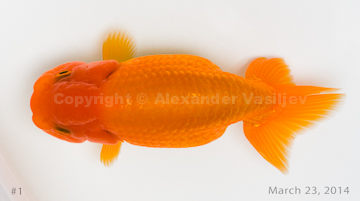Here is a short story about how this ranchu strain came to the USA. The parent fish from bloodlines developed separately by two notable Japanese ranchu masters Mr. Kazuo Suzuki and Mr. Shigeru Kageyama were imported to Thailand by Mr. Boss (Boss Ranchu Nursery) in 2009. They were cross-bred by Mr. Boss resulting in Suzuki X Kageyama cross, also known as SxK. The offsprings were imported to the USA in 2010 by Paul (Ranchumaniax) and spawned later the same year. Since then, these ranchu were bought, sold and distributed among US ranchu breeders and keepers.
The ranchu I received, were spawned by Jeff in the Summer of 2013 and I hope with the right grooming they will turn into even more beautiful fish. Here they are, so please see for yourself:
 |
| male |
 |
| male |
With the purchase of these ranchu I got a surprise present from Jeff - two glass medallions with Japanese ranchu design.
Jeff makes these glass medallions in his glassblowing studio and individually colors them to give each a unique look. I quickly found a good place for them - on the bottom of my ranchu pond.





















